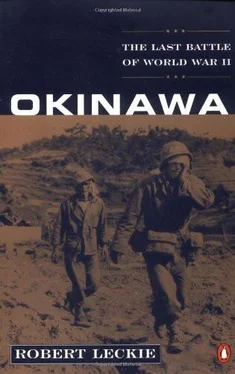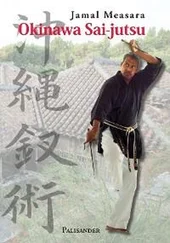These islands lie southwest of Japan proper, northeast of Formosa and the Philippines, and west of the Bonins, which include Iwo Jima. Peaks of drowned mountains, they stretch in an arc about 790 miles long between Kyushu and Formosa. Approximately in the center of the arc is the Okinawa Group of some fifty islands clustering around the largest of them, Okinawa: 60 miles long (running generally north to south), from 2 to 18 miles wide, and covering 485 square miles. Obviously such a base so close to Japan, able to support dozens of airfields, as well as dozens of divisions together with all manner of warships anchored either in the enormous Hagushi Anchorage off the west coast or the equally valuable Nakagusuku Bay off the southeast shore, would be almost “another England”—the staging area for the Allied invasion of Europe—for the waterborne attack upon Japan.
In 1945 Okinawa had a population of about five hundred thousand, of whom roughly 60 percent lived in the southern third, much more amenable than the rugged and mountainous north above the two-mile-wide Isthmus of Ishikawa.
Originally, Okinawans resembled Japanese, but an influx of Malay, Chinese, Mongol, and other races left them smaller and fuller of face than their new masters from the north. They were also among the most docile people in the world. They had no history of war, neither making nor carrying arms. (When a traveler informed Napoleon of this fact, the Corsican conqueror was indignant.) Although Jesus, Allah, and Confucius had been to Okinawa, their missionaries persuaded few if any natives to renounce their primitive animist religion based on a mystical reverence for fire and hearth and worship of the bones of their ancestors. These were placed in urns kept inside fairly large lyre-shaped tombs, which the Japanese, with their customary indifference to the feelings of any race but their own, began to fortify with machine guns and cannon at the outbreak of the war. Okinawan standards of living were low, and the Japanese made no attempt to raise them.
Generally the haughty Nipponese despised the Okinawans as inferior people and were content to regard them as hewers of wood and drawers of water, useful with their small-scale farms to supply them—and eventually their troops—with sugarcane, sweet potatoes, rice, and soybeans. Aside from teachers trained in Japan, almost all Okinawans—like the Amerindians of America—had no desire to enjoy the blessings of industrial society, but were content to live as their ancestors had lived in tiny villages of about one hundred people or towns numbering one thousand. Although the Japanese, for all of their contempt for them, had drafted many young Okinawan males into their militia, on the whole Japanese troops in the Great Loo Choo were hated with a quiet and sullen resentment similar to the attitude of the early American colonists toward the British redcoats quartered in their homes. Although the Japanese and Okinawan languages are alike, neither is intelligible to the other race.
The southern third of the island below Ishikawa, where most of the fighting would rage, is rolling, hilly country lower than the mountainous, jumbled North, but actually much easier to defend. Steep, natural escarpments, ravines, and terraces—as well as ridges abounding in natural caves—were generally aligned east and west across the island. This meant that an attacking force must engage in the most difficult warfare: “cross-hatch” fighting. There were no north-south ridges with river valleys or passes through which troops might move easily. Thus, moving south, the Americans would encounter a succession of these heavily fortified east-west ridges, and each time one fell, a new one would have to be assaulted.
The only two-way decent road in the South was in the Naha-Shuri area: Naha, the new port and commercial center; Shuri, the capital of the ancient Okinawa kings. Even these were impassable during the torrential rains that regularly turned the entire island, except for the limestone ridges, into a sea of mud—for the skies of the Great Loo Choo were capable of pouring out eleven inches of rainfall in a single day.
Just as inimical to health or endurance was an enervating humidity unrivaled even by Eritrea or the Belgian Congo, and the best description of the country lanes over which a modern, mechanized army would have to travel is an American soldier’s wry comment: “Okinawa had an excellent network of bad roads.”
Shuri Castle was the point of Okinawa’s defensive arrowhead. It lay on high ground overlooking Naha to the east (or right, as it would face the American invaders). Beneath it an ancient cave system was being extended and strengthened to provide a completely safe bomb-and shell-proof headquarters for the Japanese Thirty-second Army. Heavy guns emplaced nearby could bombard any part of southern Okinawa. If the Americans, in spite of heavy losses, were able to penetrate Shuri’s outer defenses, the defending Japanese could withdraw toward the center. So long as Shuri remained unconquered, so did Okinawa.
These fortifications resembled the blood-soaked caves and fissures of Peleliu, a drowned coral mountain that had heaved itself above the sea. But Okinawa’s were man-made; its soft coral and limestone could be grubbed up with pick and shovel, and small natural caves expanded to hold as many men as a company of two hundred or more. The fill thus removed was eminently useful in building barricades that, when soaked with water and baked by the sun, were almost as hard as concrete. But Peleliu was only six miles long by two miles wide, while southern Okinawa was about twenty miles long and in some places eighteen miles wide.
This, then, was the terrible fortified terrain that would confront the Americans when they came storming ashore in the spring of 1945. Even worse—for the seamen of the U.S. Navy, at least—would be the Japanese new weapon of the kamikaze.
No one—and especially not the members of Japanese Imperial General Headquarters or the United States Joint Chiefs of Staff—expected Okinawa to be the last battle of World War II. Why the surprise? The Joint Chiefs, having woefully underestimated enemy striking power at the beginning of the Pacific War, had just as grievously exaggerated it at the end.
Actually, as some perceptive Okinawans were already privately assuring each other: “Nippon ga maketa. Japan is finished.” In early 1945, after the conquest of Iwo Jima by three Marine divisions, the island nation so vulnerable to aerial and submarine warfare had been almost completely severed from its stolen Pacific empire in “the land of eternal summer.” Leyte in the Philippines had been assaulted the previous October by an American amphibious force under General of the Armies Douglas MacArthur, and in the same month the U.S. Navy had destroyed the remnants of the once-proud Japanese Navy in the Battle of Leyte Gulf. On January 9, Luzon in the Philippines was invaded, and on February 16—17, like a “typhoon of steel,” the fast carriers of the U.S. Navy launched the first naval air raids on Tokyo Bay. A week later Manila was overrun by those American “devils in baggy pants.” In late March Iwo fell to three Marine divisions in the bloodiest battle in the annals of American arms. Not only was Old Glory enshrined forever in American military history by the historic flag-raising atop Mount Suribachi, but more important strategically and more dreadful for Japanese fears was the capture of this insignificant little speck of black volcanic ash—a cinder clog, 4½ miles long and 2½ miles wide—for it guaranteed that the devastating raids on Japan by the new giant B-29 U.S. Army Air Force bombers would continue and even rise in fury.
Iwo became a base from which the Superforts could fly closer to the Japanese capital undetected and under protection of Iwo-based American fighter planes. Perhaps even more welcome to these gallant airmen, crippled B-29s unable to make the fifteen-hundred-mile flight back to Saipan could now touch down safely on tiny Iwo; or if shot down off the shores of Nippon, could even be reached by Iwo-based Dumbo rescue planes. Thus, not only could these exorbitantly expensive aerial elephants be saved, but their truly more valuable crews as well. On the night of March 9, to prove their worth and sound the requiem of the “unconquerable” island empire, the Superforts already striking Tokyo, Nagoya, Osaka, and Kobe in pulverizing three-hundred-plane raids came down to six thousand feet over Tokyo to loose the dreadful firebombs that consumed a quarter of a million houses and made a million human beings homeless while killing 83,800 people in the most lethal air raid in history—even exceeding the death and destruction of the atomic-bomb strikes on Hiroshima and Nagasaki that were to follow.
Читать дальше










